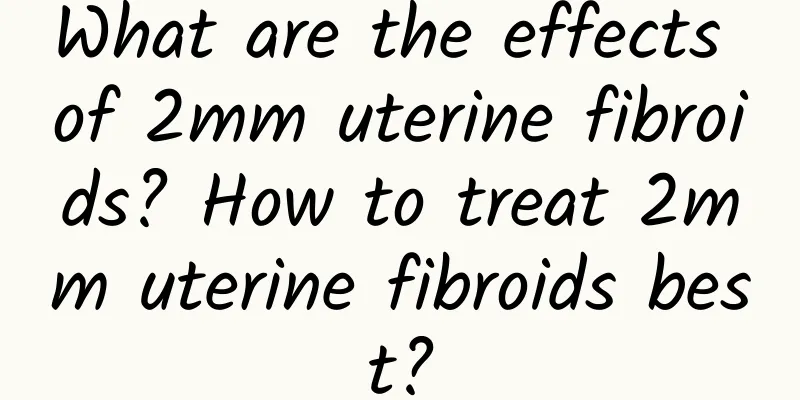What are the effects of 2mm uterine fibroids? How to treat 2mm uterine fibroids best?

|
What are the effects of 2 mm uterine fibroids: the first step to understanding the condition Uterine fibroids are a problem faced by many women. Among them, 2 mm uterine fibroids are relatively small fibroids, but they may still have some impact on the body. This article will explain the impact of 2 mm uterine fibroids and how to best treat this problem. Impact 1: Abnormal menstrual cycle Uterine fibroids as large as 2 mm may cause irregularities in the menstrual cycle. Some women may experience pain or discomfort at the beginning or end of their period. This is because fibroids increase pressure on the uterine muscles, which can cause pain and discomfort. Impact 2: Abnormal uterine bleeding Uterine fibroids as large as 2 mm may also cause abnormal uterine bleeding. Uterine fibroids can stimulate the growth of the uterine lining, which can lead to increased bleeding. This can cause noticeably heavier, longer, or irregular periods. If the bleeding is heavy, it can cause other health problems, such as anemia. Impact 3: Pregnancy problems 2mm uterine fibroids may cause some trouble during pregnancy. As the fibroids grow, they take up space in the uterus, which may not only increase the risk of miscarriage or premature birth, but may also interfere with the normal development of the embryo. Therefore, if you have uterine fibroids during pregnancy, you need to pay close attention. Treatment 1: Observation and monitoring For 2 mm uterine fibroids, observation and monitoring is a common treatment method. Because it is a smaller fibroid, some patients may not experience obvious symptoms. In this case, doctors usually recommend that patients have regular gynecological examinations to monitor the development of the fibroids. Treatment 2: Drug therapy Drug treatment is also a common method for 2 mm uterine fibroids. Some drugs can help shrink or control the growth of uterine fibroids. For example, oral contraceptives, progesterone drugs, and gonadotropin-releasing hormone drugs may be used to treat small uterine fibroids. Treatment three: surgical treatment In some cases, surgery may be the best option. For uterine fibroids that are 2 mm, surgical options include myomectomy and hysterectomy. Both of these surgeries can effectively remove the fibroids in the uterus and help restore normal uterine function. Although 2mm uterine fibroids are relatively small, they may still cause some effects on the body. Abnormal menstrual cycles, abnormal uterine bleeding, and pregnancy problems are common effects. In terms of treatment, observation and monitoring, drug therapy, and surgical treatment are common methods. Patients should choose appropriate treatment methods under the advice of their doctors and have regular gynecological examinations to monitor changes in their condition. Early detection and treatment of uterine fibroids can help protect women's health. |
>>: Why do uterine fibroids sometimes disappear suddenly?
Recommend
What tests should women do for cervical erosion? 6 tests can help you screen for cervical erosion
Cervical disease is a very common gynecological p...
What are the causes of non-gonococcal vaginitis infection?
What are the causes of non-gonococcal vaginitis i...
Does hyperprolactinemia affect pregnancy?
Prolactin is a protein hormone secreted by the pi...
What preparations should be made before artificial abortion
Artificial abortion refers to the termination of ...
How to regulate irregular menstruation for women? 5 tips to regulate menstruation to help you have smooth periods every month
Irregular menstruation is a situation that many w...
High-fiber foods that relieve constipation and help lose weight! Nutritionist Zhang Peirong recommends 5 must-eat foods
The causes of constipation, in addition to the in...
What should you eat after an abortion? What should you pay attention to after an abortion?
After an abortion, women must take good care of t...
Common causes of uterine fibroids
What are the causes of uterine fibroids? I believ...
Menstruation is late, back pain, breast pain
Menstruation is late, back pain, breast pain: Del...
What are the symptoms of miscarriage and what are the causes of miscarriage?
Vaginal bleeding in pregnant women is the first s...
How harmful are uterine fibroids to women?
The reason why most women do not pay attention to...
Excessive exercise leads to endometriosis. Diet therapy for endometriosis
Does excessive exercise cause endometriosis? What...
How much does the menopause drug cost?
Everyone knows the harm of menopause to female fr...
What are the causes of dysmenorrhea in women?
Dysmenorrhea troubles many women, and because eac...
What are the symptoms of cervical erosion in women? What is the treatment method for cervical erosion in women?
Cervical erosion is a very common gynecological d...









